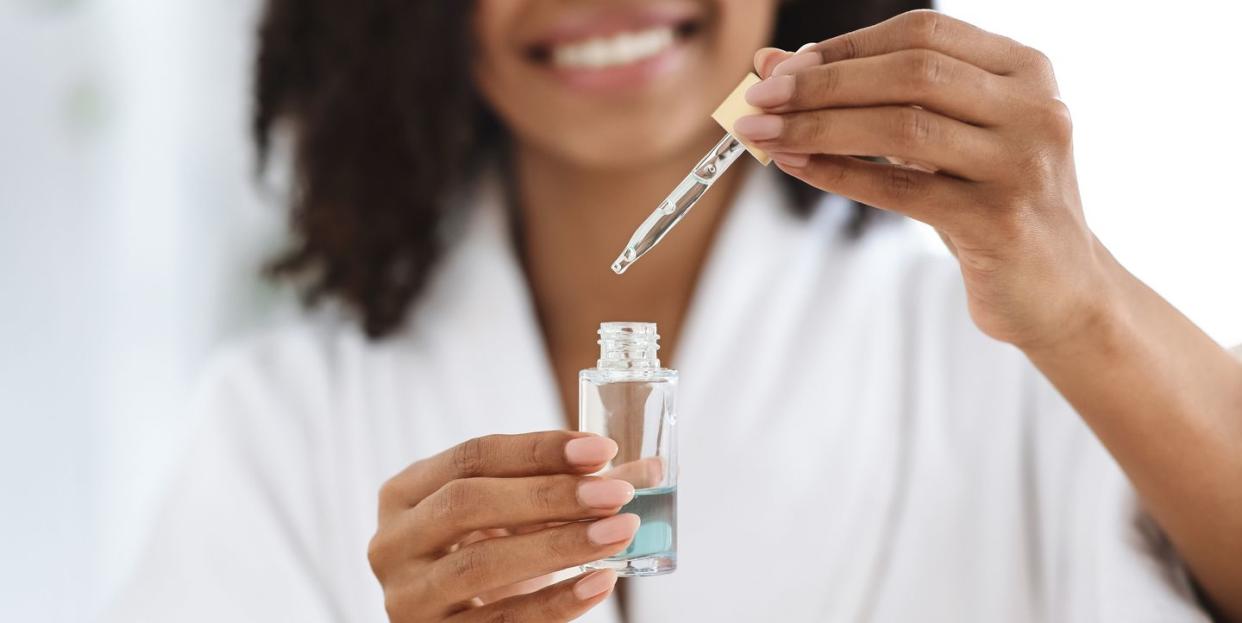Sensitive Skin? Use Niacinamide to Fade Dark Spots, Reduce Irritation, and Boost Hydration

"Hearst Magazines and Yahoo may earn commission or revenue on some items through the links below."
Everyone loves a skincare multitasker—an ingredient that makes others perform better and cuts down on serum slathering time (without sacrificing that sought-after glow). And whether you’re a skincare aficionado or simply like to be in the know when it comes to powerhouse ingredients, you’ll want to learn all the niacinamide benefits the ingredient has to offer. Here, experts break down its ease of use, gentle nature, and major skin benefits.
What is Niacinamide?
Niacinamide (also known as nicotinamide) is a form of vitamin B3. “This is also called niacin, which is an essential nutrient for the development and function of the cells in your body,” says Annie Gonzalez, M.D., a board-certified dermatologist at Riverchase Dermatology in Miami. You eat niacin in foods like chicken breast, marinara sauce, salmon, and brown rice, and consuming it helps your body convert the food you eat into energy, she says.
But benefits abound when you smooth the vitamin onto your skin. “Much like cells in your body use B3 to improve their functions, the skin utilizes it to optimize various processes, such as to repair damaged DNA, regenerate cellular energy, and reduce the effects of UV rays from the sun,” explains Dr. Gonzalez.
Niacinamide benefits
Niacinamide offers plenty of restorative perks from the inside out, but it can bring a special new buoyancy to skin.
It improves tone and fades dark spots.
If you have dark patches, sun damage, or age spots, consider them covered. “In specific concentrations, niacinamide is thought to be able to block the enzyme responsible for producing pigmentation, or melanin, and improve skin tone,” says Dr. Gonzalez.
A 2016 study in the Journal of Drugs in Dermatology looked at a product containing a cocktail of skin brighteners, including retinol, the antioxidant resveratrol, and niacinamide. Four weeks of application lessened hyperpigmentation, improved clarity, and evened skin tone, the researchers concluded.
It calms angry acne.
Niacinamide may help balance oil and sebum production to decrease breakouts, says Purvisha Patel, M.D., a board-certified dermatologist and founder of Visha Skincare.
What’s more, it’s known as an anti-inflammatory, which makes it ideal for calming acne spots and minimizing redness. Plus, past research shows that a nicotinamide gel was as effective as a topical antibiotic to treat acne.
It fights off harmful stressors.
UV rays, pollution, stress, lack of sleep, and other factors can all create free radicals (unstable molecules) that damage healthy skin cells. “This causes premature signs of aging like discoloration and wrinkles,” says Dr. Gonzalez. Niacinamide has antioxidant properties that can protect skin from this damage or even reverse some of it.
It boosts hydration.
“When used in conjunction with common moisturizing ingredients, like glycerin and hyaluronic acid, it can boost the product’s hydrating ability,” says Dr. Gonzalez.
It also supports the production of ceramides, the natural fats in your skin, which can help improve the skin’s barrier, preventing both water loss and the invasion of potential irritants. The benefit: Your skin becomes less reactive and prone to sensitivity.
It lessens irritation.
One of the best things about niacinamide is that it supports your use of potentially irritating anti-agers that increase skin cell turnover, including retinol and alpha hydroxy acids (AHA), such as glycolic acid. “It can soothe the skin and limit any irritation that can be caused by the stronger exfoliants,” says Dr. Patel.
Niacinamide side effects
The great news is that niacinamide is really gentle. “It’s a really safe ingredient. It doesn’t tend to be irritating, and anecdotally, I haven’t found patients who can’t tolerate it,” says Angela Lamb, M.D., an associate professor in the department of dermatology at Mount Sinai in New York City. Again, even people with sensitive skin, like those who struggle with rosacea, can use niacinamide. In fact, it’s often added to rosacea moisturizers because of its anti-inflammatory properties.
How to use niacinamide in your skincare routine
When shopping, look for a serum or moisturizer with 2 to 10% niacinamide, recommends Dr. Gonzalez. As for use: After washing your skin, sweep on an alcohol-free toner. Then, use your “active” anti-ager (like retinol, vitamin C, or an alpha hydroxy acid) and finish up by applying niacinamide.
If you use a serum, you can mix it with your favorite moisturizer and apply both at once, Gonzalez suggests. Smooth it over your face, neck, and around your eyes for calmer, glowing skin. Not sure what product to start with? Shop derm-approved, affordable picks below.
You Might Also Like


